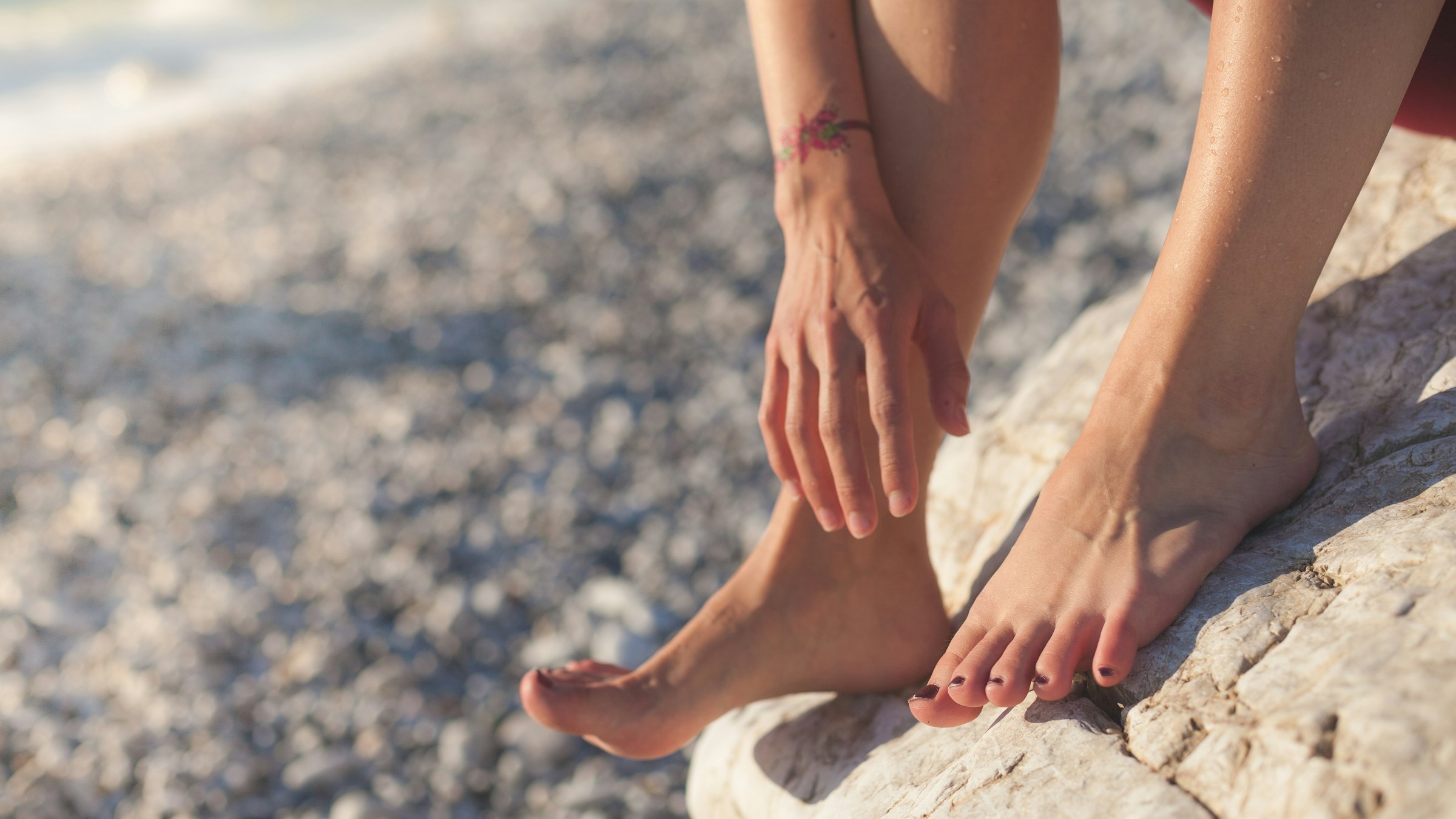
Is laying in the sun good for you? Learn the benefits of sun exposure and innovative tips to soak up the sun safely and effectively.
Warm sunbeams filter through the trees. A soft breeze rustled the grass. A cozy towel spread across the ground. And the relaxing sensation of lying in the sun. Who doesn't love a good sunbath? Sun exposure can boost your mood, help your body produce vitamin D, and even improve skin conditions like psoriasis and eczema. Prolonged sun exposure can increase your skin damage and cancer risk. The trick is to enjoy the benefits of sun exposure while avoiding the risks. This article will help you do just that with smart, science-backed sun habits. But, how to measure sun exposure?
SunSeek offers an effective solution for bright sun exposure. Our daily sunlight exposure tracker helps you enjoy the benefits of sun exposure, like boosted mood and vitamin D while avoiding skin damage and health risks. Get personalized recommendations for safe sun exposure based on location, skin type, and the time of year. Then, log your time in the sun to track your progress.
Table of Contents
Is Laying in the Sun Good for You?

There’s no doubt about it: getting some sun is good for you. Not only does laying in the sun feel nice, but it also releases beneficial vitamins and hormones into your body. Health experts recommend getting regular, measured doses of sunlight to:
Improve mood
Enhance bone health
Support immune function
Treat several skin conditions
Enhances Vitamin D Production
Sunlight is the most natural and adequate vitamin D source, often called the sunshine vitamin. When UVB rays from the sun hit your skin, they trigger the production of vitamin D, essential for:
Bone health
Immune function
Overall vitality
This nutrient helps your body absorb calcium, reducing the risk of osteoporosis and fractures. Beyond bone health, vitamin D also reduces the risk of chronic illnesses, including:
Heart disease
Diabetes
Certain cancers
How to Safely Optimize Sun Exposure for Vitamin D Based on Skin Tone, Age, and Location
Spending 10 to 30 minutes in the sun a few times a week can significantly boost your vitamin D levels. The time needed depends on skin tone, age, and geographical location. For those living in regions with limited sunlight or during winter months, vitamin D supplements may be necessary, but nothing compares to the natural benefits of sunshine.
Boosts Mood and Mental Health
Sunlight plays a crucial role in regulating mood by increasing the production of serotonin, a hormone that promotes feelings of happiness and well-being. Exposure to sunlight has been shown to reduce symptoms of depression, particularly in individuals with seasonal affective disorder (SAD), a type of depression that occurs during the darker months of the year. This is why many people feel more energetic and optimistic on sunny days.
The Mental Health Benefits of Sun Exposure: Boosting Mood, Reducing Stress, and Combating Burnout
Even a short walk outside on a sunny day can elevate your mood and improve mental clarity. Sun exposure triggers a cascade of positive effects on your brain, helping to reduce stress and anxiety. Incorporating sun exposure into your daily routine can be a natural antidote to modern-day challenges like burnout and emotional fatigue, helping you feel more balanced and energized.
Improves Sleep Quality
Sunlight helps regulate your circadian rhythm, the internal clock that controls your sleep-wake cycle. Exposure to natural light during the day signals your body to produce melatonin, the hormone responsible for inducing sleep, at the appropriate time. This synchronization ensures better sleep quality and a more restful night.
How Sunlight Supports Better Sleep: Resetting Your Internal Clock and Combating Insomnia
Spending time outdoors in the morning or early afternoon can improve sleep duration and reduce insomnia symptoms. Consistent sun exposure can help reset the internal clock for those struggling with irregular sleep patterns or frequent disruptions. This natural remedy is especially beneficial for shift workers or individuals recovering from jet lag.
Strengthens Bones
As mentioned earlier, sunlight triggers vitamin D production, essential for calcium absorption. Calcium is a critical mineral for building and maintaining strong bones. Adequate sun exposure reduces the risk of bone-related conditions such as rickets in children and osteoporosis in adults. Vitamin D also supports muscle strength, which helps prevent falls and fractures, particularly in older adults.
Boosting Bone Health Naturally: Sun Exposure, Nutrition, and Outdoor Exercise
Combining regular sun exposure with a diet rich in calcium and magnesium can ensure optimal bone health. Weight-bearing exercises, such as walking or jogging outdoors, further enhance bone density and joint health, making outdoor activities a holistic approach to skeletal strength.
Supports Immune Function
Vitamin D from sunlight exposure plays a vital role in supporting the immune system. It helps activate T-cells, essential for fighting infections and reducing inflammation. Adequate vitamin D levels have been linked to a lower risk of autoimmune diseases, such as multiple sclerosis and rheumatoid arthritis. Sunshine also boosts the production of antimicrobial peptides, providing an added defense layer against:
Bacterial
Viral
Fungal infections
The Role of Sunlight in Strengthening Immunity: Benefits and Precautions for Optimal Health
Regular sun exposure can bolster your body’s defenses against common illnesses like colds and the flu. Balance is key—overexposure can weaken the immune system and increase the risk of sunburn or skin damage, so moderation is essential to maximize benefits.
Reduces Risk of Certain Cancers
While excessive sun exposure can increase the risk of skin cancer, moderate sun exposure has been associated with a reduced risk of certain internal cancers, such as:
Colon cancer
Breast cancer
Prostate cancer
Sunlight and Disease Prevention: Balancing Vitamin D Benefits with Sun Safety
Vitamin D produced by sunlight prevents these diseases by regulating cell growth and reducing inflammation. Studies suggest that populations with higher sun exposure have lower rates of these specific cancers. Enjoying sunlight in safe, measured doses can help you reap these protective benefits while minimizing risks. Always wear sunscreen during prolonged exposure to prevent skin damage, and consider consulting a healthcare provider for personalized advice.
Promotes Heart Health
Sunlight has a beneficial effect on cardiovascular health by helping lower blood pressure. UV rays stimulate the production of nitric oxide, a molecule that relaxes blood vessels and improves blood flow. This can reduce the risk of hypertension and other heart-related conditions, such as stroke and heart attack. Spending time outdoors in the sun also enhances circulation and oxygen delivery. For individuals with a history of heart problems or elevated blood pressure, regular sun exposure can be a natural way to support overall cardiovascular health.
Boosts Energy Levels
Have you ever noticed how energized you feel after spending time in the sun? Sunlight increases the production of serotonin, which not only improves mood but also boosts energy levels. This is why people often feel, on sunny days, more:
Motivated
Productive
Physically active
Getting outside for even 15 minutes during your lunch break can help combat midday fatigue and sharpen your focus. Regular sun exposure provides a natural and sustainable energy boost without the need for stimulants like caffeine. Over time, this can improve your overall productivity and zest for life.
Reduces Inflammation
Sunlight has natural anti-inflammatory effects that can benefit individuals with chronic inflammatory conditions such as:
Arthritis
Psoriasis
Eczema
UV rays help modulate the immune response, reducing the severity of inflammation and associated symptoms. These effects make sunshine an invaluable complementary therapy for managing autoimmune and skin-related conditions.
Sunlight as a Natural Anti-Inflammatory: Tips for Safe Exposure and Special Considerations
Incorporating moderate sun exposure into your routine can complement other treatments for inflammation. Individuals with sensitive skin or conditions like lupus should consult a healthcare professional before increasing sun exposure.
Improves Skin Conditions
While excessive sun exposure can harm the skin, moderate exposure can improve certain skin conditions. UV rays have been shown to alleviate symptoms of psoriasis, eczema, and acne by reducing inflammation and slowing the overproduction of skin cells. Sunlight also helps kill bacteria on the skin’s surface, promoting a clearer complexion.
Using Sun Exposure for Healthier Skin: Benefits, Risks, and Protection Tips
Short, controlled sessions of sun exposure can help clear up blemishes and promote healthier skin. It’s crucial to balance sun exposure with proper protection to avoid long-term skin damage. Sunscreen and limited time in direct sunlight are essential for safe and effective results.
Aids in Weight Management
Sunlight may indirectly influence weight management by boosting energy levels and encouraging outdoor activities. People who spend more time outdoors are more likely to engage in physical exercise, essential for maintaining a healthy weight. Activities like walking, jogging, or cycling in the sun combine the benefits of exercise with the mood-enhancing effects of sunlight. Sunlight’s impact on mood and energy can reduce emotional eating and cravings, making it easier to stick to a balanced diet. Research also suggests that vitamin D may influence the body’s ability to metabolize fat, further supporting healthy weight management.
Promotes Longevity
Studies have suggested that regular, moderate sun exposure increases life expectancy. This is likely due to improved cardiovascular health, enhanced immune function, and better mental well-being. Sunlight’s role in reducing the risk of chronic diseases further contributes to its longevity-promoting effects. Making sunlight a part of your daily routine can support a longer, healthier life. Aim for balanced exposure that avoids the risks of overexposure, such as sunburn or skin damage. A holistic approach to sunbathing and other healthy lifestyle habits can maximize your chances of living a vibrant life.
Enhances Athletic Performance
Sunlight’s ability to boost energy and improve mood can enhance athletic performance. Outdoor exercise in the sun stimulates endorphin production, which can increase stamina and motivation. The vitamin D produced by sunlight supports muscle function, strength, and recovery, making it an essential component of an athlete’s routine. Whether running, cycling, or practicing yoga in the sun, outdoor activities offer physical and mental benefits. Sunlight helps your body recover more efficiently, ensuring you’re ready for the next workout. Just stay hydrated and protect your skin during extended periods of sun exposure.
Supports Eye Health
Moderate exposure to natural light benefits eye health, particularly in reducing children’s risk of myopia (nearsightedness). Spending time outdoors allows the eyes to focus on distant objects, which can help maintain healthy vision. Natural light also reduces eye strain caused by prolonged screen time, promoting better visual comfort. Wearing sunglasses with UV protection is essential to protect your eyes from direct sunlight. Avoid staring directly at the sun, as this can cause severe eye damage, including photokeratitis or macular degeneration.
Strengthens Social Connections
Spending time outdoors in the sun often involves social activities, such as picnics, sports, or leisurely walks with friends and family. These activities can strengthen relationships and improve emotional well-being. Social connections are a key component of overall health and longevity, and sunlight can amplify the benefits of these interactions.
The Social and Emotional Benefits of Outdoor Activities in the Sun
Sunlight’s mood-boosting effects can make social interactions more enjoyable and fulfilling. Whether you’re sharing a meal outdoors, playing team sports, or participating in group exercise, sunshine and socialization can enhance your quality of life and create lasting memories.
The Risks of Sunbathing
While the benefits of sunbathing are compelling, it’s essential to acknowledge the risks associated with excessive sun exposure. Overexposure can lead to:
1. Skin Damage
Prolonged exposure to UV rays can result in:
Sunburn: This painful condition occurs when the skin is damaged by UV radiation.
Premature Aging: UV exposure can lead to wrinkles, loss of skin elasticity, and a leathery appearance.
2. Increased Skin Cancer Risk
The most significant concern regarding sunbathing is the potential for skin cancer. The two primary types of skin cancer associated with UV exposure are:
Melanoma: This aggressive form of skin cancer is linked to intense, intermittent sun exposure and severe sunburns, particularly in childhood.
Non-Melanoma Skin Cancers: Basal and squamous cell carcinoma are more common and often associated with prolonged sun exposure.
3. Eye Damage
Excessive UV exposure can also harm our eyes, leading to conditions such as:
Cataracts: Clouding of the eye’s lens can impair vision.
Macular Degeneration: A progressive eye disease that can lead to vision loss.
4. Heat-Related Illnesses
Spending too much time in the sun can lead to heat exhaustion or heat stroke, particularly in hot weather. Staying hydrated and taking breaks in the shade is crucial to mitigate these risks.
5. Effects on Pregnant Women
Pregnant individuals should be cautious during sunbathing, as excessive heat can lead to dehydration and may affect the developing fetus. It's advisable to consult with a healthcare provider about safe sun exposure during pregnancy.
Related Reading
• Can You Get Vitamin D in the Shade
• Do You Have to Be in Direct Sunlight to Get Vitamin D
• Does Vitamin D from the Sun Make You Sleepy?
• How to Get Vitamin D in the Winter
How Much Sun Is Too Much?

The right amount of sun exposure varies from person to person based on factors like:
Skin type
Geographical location
Time of day
Dermatologists recommend getting about 15 minutes of sun exposure a few times a week without sunscreen to boost vitamin D levels. After this point, it’s a good idea to cover up or apply sunscreen to prevent UV damage.
How to Tell When to Get Out of the Sun
We all know that too much sun is harmful to your skin. But how do you know how long you can stay in the sun? You can't see or feel UV light, so it's difficult to know how strong it is and what effect it will have. Summer heat isn't a good indicator here because UV radiation might also be present when it's cold outside. This is because heat from the sun doesn't come from UV light but from infrared light in the sun’s rays.
The UV Index and What It Means for You
The higher in the sky the sun is, the stronger the UVB radiation on Earth. This is true for the sun’s position throughout the day—it’s highest at midday—and in terms of geographical location. So, UV radiation is exceptionally high and close to the equator, for instance, in:
Florida
Thailand
Central America
It is also high in Australia and New Zealand because these countries are near the hole in the ozone layer above the Antarctic. The thinner the ozone layer, the stronger the UV radiation levels. UVB exposure tends to be more prevalent in mountainous regions than lower areas. Snow, water, and light-colored sand also reflect UV light, increasing exposure.
What is the UV Index?
The UV Index (UVI) measures the current intensity of UVB radiation in a specific location. The higher the current UV Index reading, the higher the radiation levels, and the more likely you will get sunburn. UV Index (UVI)UV intensity0 to 2Low3 to 5Moderate6 to 7High8 to 10Very High11Extremely High
Understanding the UV Index: When and Where Sun Protection Matters Most
The higher the UV Index, the more protection you will need. UV radiation is exceptionally high in mountainous regions, at the equator, and in areas where the ozone layer is thin, such as Australia. In most places, UVB radiation is most substantial between 11 a.m. and 3 p.m. because the sun is high in the sky then. UVB exposure is also more of a problem in the summer than in winter. Thick clouds can reduce UV radiation, but thin clouds don't provide much protection.
How Much UV Radiation Can Your Skin Handle?
Intensive and frequent sunbathing can be too much for your skin to handle. Only if you gradually increase UV exposure over two to three weeks and only expose your skin to moderate UV radiation can you achieve a lasting tan that makes the skin’s corneal layer thicker, providing a little protection from the sun. Although this natural UV protection can prevent sunburn to some extent, it cannot protect against all the different types of damage caused by UV light and cannot prevent skin cancer.
Sun Exposure Limits Based on Skin Type: How to Avoid Sunburn and Protect Sensitive Skin
The skin of people sensitive to light can't protect itself from UV radiation for long. In very fair-skinned people, UV radiation becomes harmful after 5 to 10 minutes. The table below shows the maximum amount of time people with different types of skin can expose untanned and unprotected skin to the sun per day without getting a sunburn.
Understanding Skin Types and Sun Sensitivity: How to Determine Your Skin Type and Protect It
Skin TypeDescriptionMaximum Amount of Time
Skin type IVery light skin, often with freckles, reddish or strawberry blond hair, and blue or gray eyes. UV radiation leads to sunburn within 10 minutes, skin doesn't tan. 10 minutes
Skin type IILight skin, often with freckles, blond or brown hair, and all eye colors. UV radiation leads to sunburn within 20 minutes. Skin hardly tans or tans only moderately. 20 minutes
Skin type IIILight or light brown skin, rarely with freckles, dark blond or brown hair, and gray or brown eyes. UV radiation leads to sunburn within 30 minutes, and skin tans easily. 30 minutes
Skin type IVLight brown or olive-colored skin, no freckles, dark brown hair, and brown or dark brown eyes. UV radiation leads to sunburn within 50 minutes. Skin soon becomes deeply tanned. 50 minutes
Skin type VDark brown skin, dark brown or black hair, and dark brown eyes. UV radiation only leads to sunburn after more than 60 minutes; the skin doesn't become darker. More than 60 minutes
Skin type VIDark brown or black skin, black hair, and dark brown eyes. UV radiation only leads to sunburn after more than 60 minutes; the skin doesn't become darker. More than 60 minutes
Skin Types and Geographic Origins: How Location Influences Sun Sensitivity
Very light skin and light skin (types I and II) are typical in places like Scandinavia and Great Britain, and people who have a medium brown skin tone with dark eyes and dark hair (type IV) mainly live in the Mediterranean and geographically similar areas. People with even darker or black skin (types V and VI) have roots in some regions of Asia or Africa.
Related Reading
• Can You Get Vitamin D from the Sun Through a Window?
• Best Time of Day to Get Vitamin D from the Sun
• Can You Get Vitamin D on a Cloudy Day?
• Can You Get Vitamin D from the Sun After 4 PM?
10 Tips to Help You Sunbathe Correctly

1. Time It Right to Soak Up the Rays
Sunbathing between 10 a.m. and 4 p.m. isn’t the best idea. These peak sunshine hours deliver the most intense ultraviolet radiation, increasing your chances of sunburn and skin damage. Instead, plan your sunbathing sessions for early morning or late afternoon when the sun’s rays are less harmful.
2. Cover Up to Lower Your UV Exposure
Wearing clothing is one of the easiest ways to protect yourself from UV radiation when lying in the sun. Cover up areas prone to burning, like:
The shoulders, back, and face
With loose-fitting, lightweight clothing
Look for garments that offer ultraviolet protection factor (UPF) ratings for the best defense against harmful rays.
3. Don’t Skip the Sunscreen
Sunscreen is a must, even if you have darker skin. Too much sun can lead to skin damage and even cancer, regardless of your complexion. Choose a broad-spectrum sunscreen with an SPF of at least 30 for best results. Apply the lotion generously to all exposed skin 15 minutes before sun exposure. Reapply every two hours or immediately after swimming or sweating.
4. Seek Shade When You Can
Limiting your cumulative UV exposure is essential, and one way to do that is to take breaks in the shade while lying in the sun. Doing so helps your skin recover and reduces your risk of burning.
5. Protect Your Eyes, Too
Your skin isn’t the only body part that needs protection from UV radiation; your eyes do, too. Prolonged exposure to the sun’s rays can lead to cataracts and other eye damage. To shield your peepers from harmful UV rays, wear sunglasses that block 100% of UVA and UVB rays.
6. Hydrate While You Sunbathe
Staying hydrated is another way to make your time in the sun safer. Laying in the sun can lead to increased perspiration and potential electrolyte imbalances. Drink plenty of water or non-alcoholic, non-caffeinated beverages while sunbathing to counteract these effects.
7. Set a Timer for Sunbathing
Limit the duration of your sun exposure. This is especially critical during winter when the sun’s rays can still be harmful, but you may be more tempted to spend extended hours outdoors. To help monitor your time in the sun, set a timer or use an app on your phone.
8. Say No to Tanning Beds
Indoor tanning is just as risky as outdoor sunbathing. Exposing your skin to artificial UV radiation increases your chances of developing skin cancer and premature aging. If you want to achieve a bronzed look, opt for sunless tanning lotions or sprays instead.
9. Watch Out for Medications That Increase Sun Sensitivity
Some medications can increase your skin’s sensitivity to the sun. These include certain antibiotics and acne treatments. Always read medication labels for sun-related precautions. If you’re unsure, consult your physician or pharmacist.
10. Beware of Reflective Surfaces
While lying in the sun, be mindful of reflective surfaces. Water, sand, and snow can all reflect UV rays and intensify exposure. When sunbathing near these surfaces, take extra precautions by:
Using sunscreen
Wearing protective clothing
Seeking shade
Related Reading
• Vitamin D from the Sun Benefits
• Is It Better to Take Vitamin D in the Morning or at Night?
• Benefits of Sunlight for Skin
• Best Sun Tracker App
• Vitamin D3 Near Me
Download Our App to Track your Daily Sunlight Exposure Today

SunSeek helps you optimize your daily sunlight exposure by tracking and providing personalized recommendations based on your:
Location
Skin type
Health goals
The app combines real-time UV monitoring with guided outdoor activities throughout the year to help you:
Improve sleep
Boost energy levels
Maintain optimal vitamin D levels.
By aligning your daily routine with natural light cycles, SunSeek makes harnessing sunlight's health benefits easy while ensuring safe exposure through personalized timing recommendations and cloud coverage forecasts. Download our app now for your daily sunlight exposure tracker.


